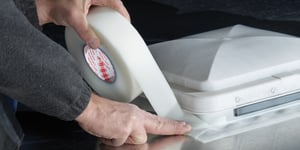Working on a project design is challenging, and between strict deadlines, tight budgets, and performance demands, selecting a practical bonding application can be complex.
Adhesive bonding is bringing two or more surfaces together using a viscous substance. To select the right one, modern manufacturers need to consider each substance's adhesive performance and any assembly advantages a solution may possess.
Strouse has worked for over three decades to use bonding tape to its fullest extent for unique products and applications.
Let’s dive into the options available before we elaborate on (spoiler alert) why bonding tape is so widely used and recommended.
What Are My Bonding Options?
For years, engineers relied on screws, bolts, mechanical fasteners, rivets, welding, and liquid adhesives to create permanent bonds between substrates.
While these materials can work for the right project, they often have unintended consequences:
- Screws, bolts, and other mechanical fasteners can all significantly increase the weight of a product and, in some cases, can impact product performance. Plus, they don’t handle vibration well over a long period.
- Rivets are permanent fasteners that punch through the material of lighter-weight solutions, creating an uneven bond with vulnerable stress points that can fail on minimal impacts.
- Welds are strong permanent bonds, but the process can be time-consuming and disruptive in an otherwise efficient assembly process.
- Liquid adhesives create lightweight, high-performance bonds, but they can be tedious, messy, and, like welds, time-consuming to apply.
Finally, there’s bonding tape, which we’re about to cover. Bonding tape includes a wide variety of adhesive materials that can help you avoid the downsides of liquid adhesive and mechanical fasteners.
Why Use Bonding Tape In Your Solution?
Bonding tape, including pressure sensitive adhesive tape, is a category of adhesives that offers many assembly advantages and versatility.
1. STRENGTH
Let’s start with the main reason to use adhesive bonding: to bring (and keep) surfaces together.
Thanks to recent innovations, bonding tapes have become some of the most durable materials available. Some self-curing adhesives create bonds nearly as strong as the components they adhere to.
For example, 3M VHB (Very High Bonding Tape), a fully cured pressure-sensitive adhesive tape, is a powerful bonding tape that outperforms traditional bonding solutions and is 10x stronger than rivets.
In addition to strength, think about versatility. Most assembly options are acceptable for metal-to-metal or plastic-to-plastic attachments, but bonding tape can create a secure bond between surfaces that aren’t the same.
2. STRESS DISTRIBUTION
Regarding strength and versatility, bonding tapes can be used in many bonding applications to replace rivets, welds, and other fasteners with concentrated stress points. Strips of tape along a surface spread stress loads across the entire tape area, not on one specific point.
Tape’s high-performance and permanent bonds hold up better against shear stress than many other bonding options.
3. APPEARANCE
Bonding tape creates a tight connection without adding unsightly bulk. When using bonding tape, design engineers can expand options for a more aesthetically pleasing look as opposed to protruding fasteners or weld burns.
Plus, bonding tape’s light weight can help reduce material thickness, which isn’t possible with welds or mechanical fasteners. Adhesive bonding leaves a smooth and seamless bond that performs beautifully and effectively. This matters in any design environment where graphics and exteriors are highly visible, such as an automobile.
4. PRODUCTIVITY
On the production floor, time is always money. Bonding tapes are easy to use and apply, helping speed assembly, decreasing labor hours, and reducing manufacturing costs.
Machine automation allows bonding tape to be distributed and implemented quicker than ever, making the assembly process more efficient, accurate, and consistent. Automated robotic systems streamline the assembly of custom products in previously unavailable ways.
Finding a Bonding Solution
If bonding tape sounds right, how do you get started?
When you’re looking for custom joining, mounting, and bonding materials that can help you avoid the downfalls of mechanical fasteners, you’ll want to narrow down the type of material you want to use.
Consider working with a full-service adhesive tape converter to find the necessary materials, develop a production process, and watch adhesives become vital to your project's success.
Originally published: November 4, 2020







